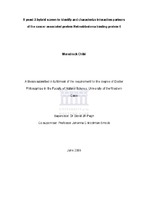| dc.description.abstract | Acute respiratory infections (ARI) continue to be the leading cause of acute illnesses
worldwide and remain the most important cause of infant and young children mortality. Many viruses such as rhinoviruses, influenza viruses, parainfluenza viruses, respiratory syncytial viruses, adenoviruses and coronaviruses are deemed to be the etiological agents responsible for ARI’s in children. The recently discovered coronaviruses HCoV-HKU1 and HCoV-NL63 contribute significantly to the
hospitalization of children with ARI’s. HCoV-NL63 was first identified in 2004, as the pathogen responsible for the hospitalization of a 7 month old child presenting with coryza, conjunctivitis and fever. Since then a significant amount of knowledge has been gained in the clinical spectrum on this virus, however HCoV-NL63 is still not well characterized on the molecular and proteomic level. This dissertation focuses on bringing about this characterization by cloning the HCoV-NL63 Nucleocapsid gene to be expressed in a bacterial system and transfecting the Nucleocapsid, Membrane and Envelope genes into a Mammalian cell culture system in order for its respective proteins to be expressed. With the use of Bioinformatic analytic tools certain characteristics of HCoV-NL63 Nucleocapsid, Membrane and Envelope proteins are able to be identified, as well as certain motifs and/or regions that are important in the functioning of these proteins. By comparing the results obtained for HCoV-NL63 N,M and E to other well studied coronavirus homologous will enlighten us on the potential role(s) of these proteins in determining HCoV-NL63 pathogenicity and infectivity. vi Although certain functions of these proteins can be deduced by the means of bioinformatics analysis, it is still imperative for it to be extensively characterized In Vitro. This will therefore form a fundamental step in the development of many other projects, which unfortunately fall outside the scope of this M.Sc thesis. | en_US |




